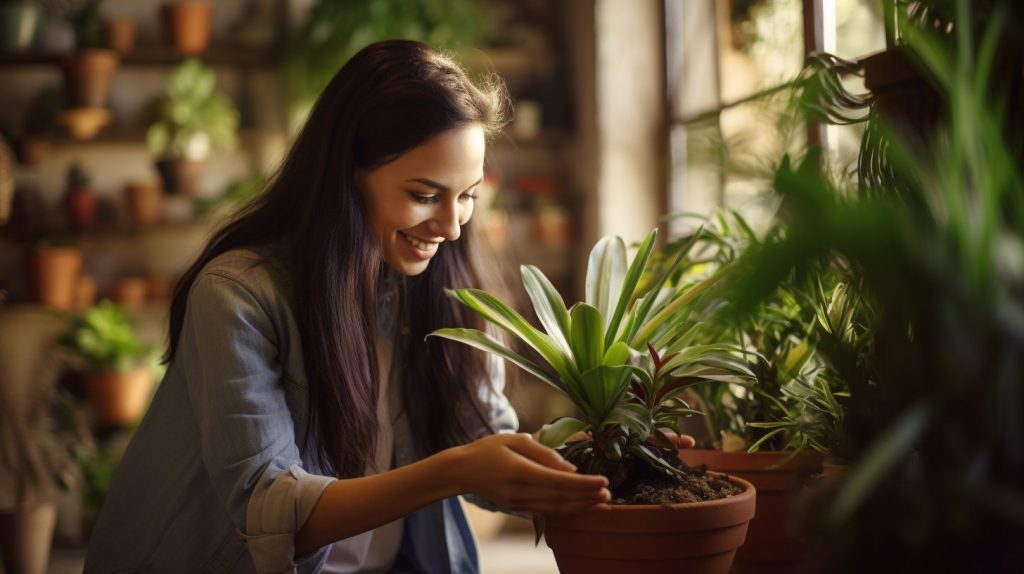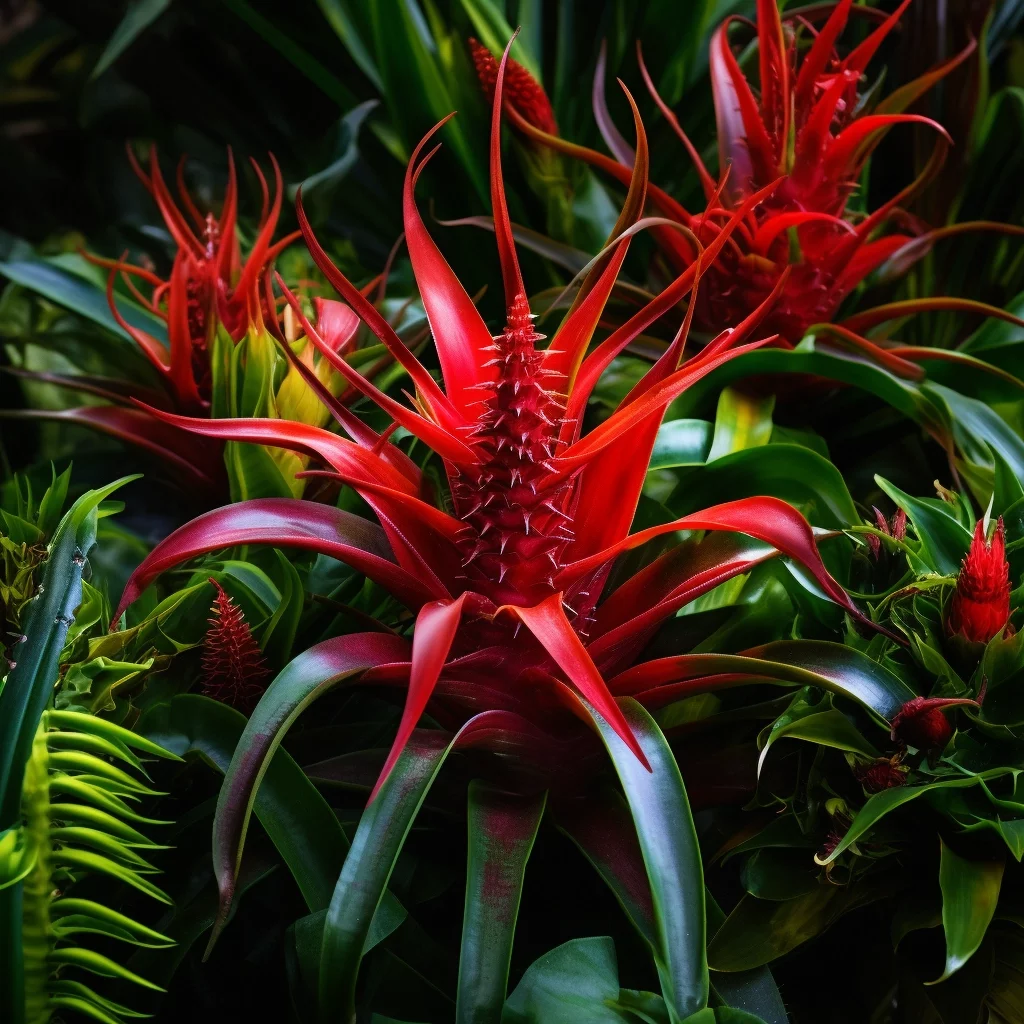Bromeliads, with their tropical allure and low-maintenance charm, have captivated the hearts of indoor plant enthusiasts worldwide. These members of the Bromeliaceae family, not only infuse vibrant colors and unique textures into your living space but also boast an intriguing life cycle, with showy flowers that mark a once-in-a-lifetime event. In this guide, we’ll dive deep into the world of bromeliads, exploring everything from their basic needs to advanced care tips, ensuring your bromeliads not only survive but thrive indoors. 🌺🍃

Getting to Know Bromeliads
Bromeliads are a celebration of diversity and resilience. They adapt remarkably well to indoor environments, offering a splash of tropical charm with minimal fuss. But before we delve into their care, let’s get acquainted with these beauties:
- Epiphytic Wonders: Often found clinging to trees in their natural habitat, bromeliads can grow without soil, absorbing moisture and nutrients through their leaves.
- A Riot of Colors: Their foliage and flowers come in a mesmerizing array of hues – from fiery reds to sunny yellows, deep purples, and vibrant greens.
- Unique Growth Pattern: Bromeliads bloom once, displaying spectacular flowers. Post-blooming, they focus on producing pups (baby plants), ensuring a continual legacy.
The Basics: Bromeliad Profile
Understanding the basic profile of bromeliads is key to providing them with the right care:
| Characteristic | Details |
|---|---|
| Common Name | Bromeliad |
| Botanical Name | Bromeliaceae genera |
| Nicknames | Air Plant, Pineapple Plant, etc. |
| Family | Bromeliaceae |
| Plant Type | Perennial |
| Mature Size | Varies (from small air plants to large terrestrial types) |
| Sun Exposure | Prefers bright, indirect light |
| Soil Type | Well-draining, often a mix of peat, bark, and perlite |
| Water Needs | Moderate; central cup filled with water, soil should dry out between waterings |
| Temperature | Thrives between 60-85°F (15-29°C) |
| Humidity | Prefers humid conditions |
| Flowering | Known for vibrant flower spikes; blooms once |
| Propagation | Through pups (offshoots) after flowering |
| Growth Habit | Can be epiphytic (growing on other plants) or terrestrial |
| Special Features | Unique rosette of leaves, some varieties fill with water |
Tailored Care for Thriving Bromeliads
To keep your bromeliads happy, consider these tailored care tips:
- Lighting Needs: Most varieties flourish in bright, indirect light. Too much direct sunlight can scorch their leaves, while too little can dull their vibrant colors.
- Watering Wisdom: Water through soil or the central cup, allowing the soil to dry out between waterings. Quality matters – use rain, filtered, or distilled water to avoid mineral build-up.
- Soil Secrets: A mix of peat-based soil and sand ensures fast drainage, crucial for their health.
- Temperature and Humidity: Aim for 60-85°F and moderate humidity (40-50%). They can tolerate a range but thrive in steady conditions.
Growing Bromeliads Indoors
Growing bromeliads indoors is a delightful way to bring a touch of the tropics into your home. These plants are revered not only for their striking appearance but also for their adaptability to indoor environments. When cultivating bromeliads indoors, it’s essential to mimic their natural habitat to the best of your ability. This means providing them with ample bright, indirect light, as they are accustomed to the dappled sunlight of forest canopies.
A north or east-facing window is ideal, but if such light conditions are not available, consider using grow lights. Additionally, these tropical beauties thrive in warm, humid conditions. If your home’s air is dry, especially in winter, using a humidifier or placing the plant on a water-filled pebble tray can help maintain the humidity levels they love. Remember, the key to a thriving indoor bromeliad is not just about meeting its basic needs but creating an environment where it can flourish.
In terms of soil, bromeliads require well-draining mixtures. A blend specifically designed for bromeliads or orchids, typically containing ingredients like pine bark, perlite, and peat, is perfect. For those bromeliads that are epiphytic, attaching them to pieces of bark or moss can be an innovative and natural-looking way to grow them. When watering, it’s important to strike a balance.
The soil should be allowed to dry out between waterings, but their central cup, formed by the rosette of leaves, should be kept filled with water. Be cautious of overwatering, as this can lead to root rot, a common issue with indoor bromeliads. Fertilization is another aspect to consider; these plants are light feeders, so a mild, diluted fertilizer applied sparingly during the growing season will suffice. With these care tips, bromeliads can be easily grown indoors, adding a vibrant and exotic flair to your living space.
Indoor cultivation of bromeliads comes with a unique set of guidelines:
- Potting Mix: Opt for a well-draining, airy mix. A combination of orchid bark, perlite, and peat works wonders.
- Fertilization: They are not voracious feeders. Use a diluted liquid fertilizer sparingly during the growing season for a nutrient boost.

Bromeliads in the Great Outdoors
While primarily indoor plants, bromeliads can enjoy the outdoors in the right conditions:
- Tropical Haven: In warmer climates, bromeliads can be a stunning outdoor addition. Ensure they are protected from extreme temperatures and direct sunlight.
- Shaded Bliss: Placing them under larger plants or on shaded patios helps mimic their natural habitat.
Exploring Bromeliad Varieties
From the striking Guzmania to the colorful Neoregelia and the elegant Vriesea, bromeliads come in an array of types, each with its unique care needs and visual appeal. Understanding these differences is key to selecting the right bromeliad for your space.
Propagation: Continuing the Bromeliad Legacy
Propagation is a rewarding aspect of bromeliad care. Once the mother plant blooms, it will start producing pups. These can be separated and grown into new plants, ensuring a continuous display of bromeliad beauty in your home.
Dealing with Pests and Encouraging Blooms
Bromeliads are generally hardy but watch out for mealybugs, aphids, and scale. Interestingly, exposing bromeliads to ethylene gas (like from a ripe apple in a sealed bag) can coax them into blooming.
Navigating Common Bromeliad Challenges
Overwatering, hard water, and the wrong container can spell trouble. Also, be aware that bromeliads are sensitive to metal, so choose your containers wisely.

Frequently Asked Questions About Bromeliad Plant Care
1. What is a Bromeliad Plant?
A Bromeliad plant, part of the Bromeliaceae family, is a tropical plant known for its vibrant foliage and unique flower spikes. The family includes many bromeliads like Tillandsia (commonly known as air plants), and the well-known pineapple. Bromeliads can be epiphytic, growing on other plants or structures without harming them, or terrestrial, growing in soil.
2. How Do I Care for a Bromeliad Plant?
Caring for a bromeliad plant involves ensuring it receives bright, indirect light, maintaining a humid environment, and watering it correctly. The central rosette of leaves often forms a cup that can be filled with water, and the soil around it should be allowed to dry out between waterings. These tropical plants thrive in well-draining soil and prefer temperatures between 60-85°F.
3. Are Bromeliads Easy to Grow Indoors?
Yes, bromeliads are easy to grow indoors as houseplants. They adapt well to indoor conditions, especially if they are provided with sufficient bright light and humidity. Many varieties, such as the epiphytic bromeliads, can be grown attached to a piece of bark or moss, adding a unique element to your indoor plant collection.
4. What Should I Do When My Bromeliad Plant Begins to Die After Flowering?
It’s natural for a bromeliad plant to die back after flowering, as most species bloom only once. However, before the main plant dies, it often produces pups (baby bromeliads) at the base. These can be propagated to grow new plants. Allow the pups to reach about one-third of the size of the parent plant before gently separating them.
5. Can I Grow Different Species of Bromeliads Together?
Absolutely! Growing many types of bromeliads together can create a visually appealing and diverse display. Each species, from the colorful Tillandsia to tank bromeliads, has unique care needs, but most thrive in similar conditions of bright light and humidity, making them great companions in a shared space.
6. How Do I Water and Fertilize My Bromeliad?
Bromeliads should be watered by filling the central cup of the plant and allowing excess water to drain through the soil. They prefer rainwater, distilled water, or filtered water to avoid mineral buildup. Fertilize sparingly with a diluted liquid fertilizer, as bromeliads are not heavy feeders.
7. What Are Common Issues with Bromeliad Plants?
Common issues include root rot due to overwatering and leaf burn from too much direct sunlight. Bromeliads are also prone to pests like mealybugs and scale. Ensuring proper watering and placing your bromeliad in bright, indirect light can prevent these issues.
8. Do Bromeliads Need Special Soil?
Yes, bromeliads do best in well-draining soil. A mix of peat, pine bark, and perlite or sand is ideal. For epiphytic bromeliads, attaching them to bark or moss can be an alternative to soil.
9. Can Bromeliads Grow in Low Light?
While bromeliads prefer bright, indirect light, many types can tolerate lower light levels. However, lower light may result in less vibrant foliage and fewer blooms. Adjust care accordingly if your bromeliad is placed in a lower-light area.
10. How Long Do Bromeliad Flowers Last?
The flower spike of a bromeliad can last several months, depending on the species and environmental conditions. After the flower dies, the plant will gradually begin to decline, but this process also starts the generation of new pups.
11. Are Bromeliads Safe for Pets?
Most bromeliads are non-toxic to pets, making them a great choice for pet-friendly households. However, it’s always best to keep any houseplant out of reach of curious pets.
12. Can I Join a Bromeliad Society?
Joining a bromeliad society can be a fantastic way to learn more about these plants, share experiences, and connect with other enthusiasts. Many societies offer resources, workshops, and events focused on bromeliad care and cultivation.
Remember, bromeliads, with their diverse genera and easy-care nature, can be a delightful addition to any plant family, bringing a touch of the tropics to your indoor garden. Whether you’re a seasoned grower or new to plant care, the world of bromeliads offers endless varieties and fascinating growth habits to explore and enjoy. 🌿🌸

